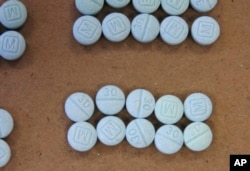The United States has its worst heroin and opioid crisis in more than 60 years. In 2015, mostly due to the heroin and opioid painkiller epidemic, more than 52,000 deaths in the U.S. were related to drug overdoses, the highest number in U.S. history, according to the State Department's International Narcotics Control Strategy Report released Thursday.
Ambassador William Brownfield briefed reporters on the release. The Assistant Secretary for International Narcotics and Law Enforcement Affairs said that the incredible demand is domestic, but that 100 percent of all heroin, and the great majority of all synthetic drugs that are used and abused in the United States, come from other countries.
He estimates that between 90 and 94 percent of all heroin consumed in the U.S. comes from Mexico and that as little as 2-4 percent of it comes from Colombia. The remainder, around 4-6 percent, comes from Asia, mainly from Afghanistan.
The U.S. has more communities, more families, more regions and towns confronting an explosive drug addiction problem related to heroin, opioids and to fentanyl and other synthetic drugs now than in the immediate post World War II era.
Brownfield said the potent and wildly addictive drug fentanyl is mostly coming in its raw form from China. He said it processes through Mexico, where it enters into that trafficking stream and moves north into the United States and Canada.
"And it then becomes an exceptionally dangerous product in the United States," said Brownfield, "because fentanyl is 10-50 times as potent as heroin, and when the user does not realize that he or she is consuming fentanyl and not consuming heroin, the likelihood of overdose and death is extremely increased.”
Brownfield had high praise for China for working with the United States to control fentanyl and 130 new synthetic drugs, saying this is saving lives in the U.S. He said cooperation between the U.S. and China has improved “astronomically” during the past four years.
He was asked about whether President Donald Trump’s plan to build a wall along the U.S. southern border with Mexico would help stop the flow of heroin and other drugs.
Brownfield said the U.S. and Mexico have developed a law enforcement “cooperative wall” at this point without having the physical construction of a wall. But he said since the president has been clear on his intentions to build a wall, the State Department will integrate any new realities into their efforts to curb drug trafficking across the U.S.-Mexico border.
Brownfield said the State Department has determined for more than 20 years that the U.S. and Mexico share responsibility for the drug problem, and that it requires shared solutions.
He added that though the U.S. drug epidemic is unprecedented, the United States is also much better positioned with the mechanisms and international cooperation it has in place today to confront the crisis than it would have been 20 years ago.







